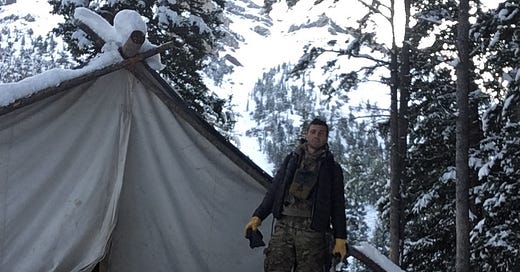Welcome to the Wasteland
“It was a wasteland, shimmering with its belts and plains of moonlit sand, blank and mysterious in its shadows, an abode of loneliness. An inexplicable sadness pervaded Adam’s soul. This wasteland and he seemed identical. How strange to feel that he did not want to leave it.”
–Zane Grey, Wanderer of the Wasteland
Eight years ago, I was staring at a barren sagebrush desert in southeastern Idaho and felt the strange loneliness everyone feels when they leave an old life behind. At the same time, I felt I had finally arrived.
I had always wanted to hunt far away from my home in New York and explore trackless wilderness. Little did I know, my ticket out of civilization would come first as a job working as a cook and guide for a hunting outfitter. When I arrived, I was something small in a silent, wild, and empty place. And I liked it.
The ups and downs of my time in Idaho inspired me to write, and I was pretty bad at first. But I stuck with it and learned enough to get a job as an editor at my favorite hunting magazine. Just as in Idaho, I had a lot to learn, and I had to learn it fast.
After four-and-a-half years with the magazine, I decided to leave my post for more time to work on other projects. One of those projects is this newsletter, in which I hope to share what a few friends and I have found while hunting, fishing, and writing for a living. So here we are.
Why the Name Wasteland?
The wilderness has not always been the wilderness. To hunters and gatherers, it was simply the world, and that world was boundless. As we became civilized, the woods and plains we once called home looked more foreboding. Those who moved away from the wilderness regarded it as a place of immorality and laziness, a place where strange beasts lived, and an obstacle to their ambition. Because civilized people had no use for wild land, they came to call it “wasteland.”
The term first appeared in the late 1800s, but its roots go deeper than that. The idea of a wasteland may have started soon after the first stone walls were built or the first farm field was planted. Once we abandoned the forests for civilized life, we became hell-bent on turning them into our strange, new idea of paradise.
Part of that attitude is still here among many modern people. It’s sometimes disguised as progress. But the wasteland is still here, too, and for now, it's here for all of us.
Hunters and anglers have always felt at home in the wasteland—whether that’s an untillable swamp behind a housing development or a 50,000-acre tract of mountain wilderness. The wasteland is marginal land, and it is in the margins that outdoors people live their true lives.
I’ve also decided to call a hunting and fishing newsletter Wasteland because, in my opinion, the woods are not always a pretty place—especially today. I’ve shot at ducks while sitting next to chemical plants and stalked deer in farm fields soaked with the chemicals those factories produce. I’ve hunted turkeys on strip mines and pulled fish from fouled water. The landscape has been scarred, and I don’t think it’s right to carry on as if it hasn't.
Wasteland is here to celebrate our wild places as they are while we have them—the places hunters and anglers come alive in, the places the civilized world often ignores. I’m not here to sell you gear you don’t need or make you feel like the buck you shot isn’t big enough. Why we go outside is much deeper than that. This newsletter is about the wilderness, big and small, and the stories we bring home from it.
Welcome to the Wasteland.





